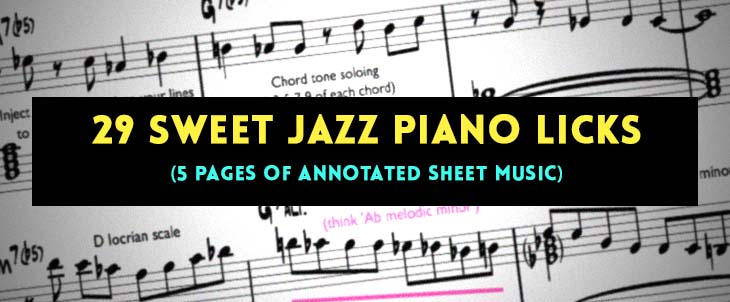How to practice the 2-5-1 in all 12 keys
What's the #1 goal for new Jazz piano students?
I would say this:
Learn the 2-5-1 through all 12 keys.
Once you can do this you'll have a solid foundation for everything else.
But how do you actually practice something in all 12 keys?
What does it look like to "take it through all 12 keys"?
There's three patterns to choose from:
Pattern 1 (descend in half-steps)
Play the 2-5-1 and descend in half-steps through all 12 keys:
Dm7 - G7 - C maj 7 (key of C major)
C#m7 - F#7 - B maj 7 (key of B major)
Cm7 - F7 - Bb maj 7
Bm7 - E7 - A maj 7
Bbm7 - Eb7 - Ab maj 7
Am7 - D7 - G maj 7
Abm7 - Db7 - Gb maj 7
Gm7 - C7 - F maj 7
F#m7 - B7 - E maj 7
Fm7 - Bb7 - Eb maj 7
Em7 - A7 - D maj 7
Ebm7 - Ab7 - Db maj 7
Dm7 - G7 - C maj 7 (ends back in C major)
(This pattern gives you a nice sounding modulation every time you shift to the next ii-V-I).
Pattern 2 (descend in 5ths).
Play the 2-5-1 and descend in 5ths through all 12 keys:
Dm7 - G7 - C maj 7 (key of C major)
Gm7 - C7 - F maj 7 (key of F major)
Cm7 - F7 - Bb maj 7 (key of Bb major)
Fm7 - Bb7 - Eb maj 7
Bbm7 - Eb7 - Ab maj 7
Ebm7 - Ab7 - Db maj 7
Abm7 - Db7 - Gb maj 7
(respell to #s) C#m7 - F#7 - B maj 7
F#m7 - B7 - E maj 7
Bm7 - E7 - A maj 7
Em7 - A7 - D maj 7
Am7 - D7 - G maj 7
Dm7 - G7 - C maj 7
Pros: Easy to remember (down a 5th every time).
Cons: Your hands have to change position every time.
Free Resource: Download my '29 Jazz Piano Licks' sheet music.
Pattern 3 (my personal favorite)
Play the 2-5-1 and descend in whole-steps through the first six keys:
Dm7 - G7 - C maj 7 (key of C major)
Cm7 - F7 - Bb maj 7 (key of Bb major)
Bbm7 - Eb7 - Ab maj 7
Abm7 - Db7 - Gb maj 7
F#m7 - B7 - E maj 7
Dm7 - G7 - C maj 7 (back to C major)
Next, count up a half-step and play through the six remaining keys:
C#m7 - F#7 - B maj 7 (key of B major)
Bm7 - E7 - A maj 7 (key of A major)
Am7 - D7 - G maj 7
Gm7 - C7 - F maj 7
Fm7 - Bb7 - Eb maj 7
Ebm7 - Ab7 - Db maj 7
This is my favorite '12 key pattern' because my hands can stay in the same place. There's no jumping around.
All I have to do is jump up an octave once - whenever it sounds too low or muddy (depending on what I'm practicing).
If you're not sure which pattern to use - use this one.
"What about the minor ii-V-I?"
Yes - all of these patterns will work for the minor 2-5-1 as well.
Same root notes. Just change the types of 7th chord.
Here's the minor 2-5-1 using pattern #3:
Dm7b5 - G7 - Cm7 (in C minor)
Cm7b5 - F7 - Bbm7 (in Bb minor)
Bbm7b5 - Eb7 - Abm7
Abm7b5 - Db7 - Gbm7
(respell to #s) F#m7b5 - B7 - Em7
Em7b5 - A7 - Dm7
Dm7b5 - G7 - Cm7
Count up a half-step for the remaining six keys:
C#m7b5 - F#7 - B min 7 (key of B minor)
Bm7b5 - E7 - A min 7 (key of A minor)
Am7b5 - D7 - G min 7
Gm7b5 - C7 - F min 7
Fm7b5 - Bb7 - Eb min 7
Ebm7b5 - Ab7 - Db min 7
C#m7b5 - F#7 - B min 7
Today's challenge:
If you haven't yet learned to play the 2-5-1 in all 12 keys, this is your #1 goal.
Choose one of the patterns above (I recommend #3), and spend the next two weeks mastering the major 2-5-1.
Get to the point where you can play the 2-5-1 through all 12 keys, note-perfectly, three times in a row.
Simple chord voicings is all you need.
I've notated the sheet music to show you (pattern #3) here:
Recommended Lesson
'Rootless Chord Voicings for Jazz Piano'
If you only learn one type of chord voicing - learn this one:
Free Resource: Download my 'Jazz Piano Chord Voicing Guide'.
Transform your playing just by adding these chord voicings to your playing.
What's Popular Now
'29 Jazz Piano Licks' sheet music

'Chord Voicing Guide for Jazz Piano'
This 11-page guide shows you chord voicings that professional Jazz pianists use.
6 pages of sheet music. Shares my top chord progressions and chord voicings.
One page cheat sheet. Shows you all common Jazz chords notated clearly:
